Mount Rainier
Statistics
- Date - 07/30-31/2004
- Elevation - 14,411'
- Route - Disappointment Cleaver
- Miles - 18.0
- Elevation Gain - 9,000'
- ACME Mapper - Link
- CalTopo - Link
- Partners - Brandon Kirby
Description
When I first started hiking in northern Idaho seven year ago, I remember talking to a friend about how cool it would be to climb Mount Rainier. Of course at the time, I was hiking in cotton socks and denim shorts so Mount Rainier could just have easily been Mount Everest. Over the past several years, I put a few miles behind me, gained a few skills, got in better shape, and traded in the old leather boots and wooden hiking stick for crampons and an ice axe. Because of this, the summit of Mount Rainier didn’t appear as unattainable as it had in the past.
I asked several friends and hiking partners if they would be interested in attempting Mount Rainier utilizing a guide service. Brandon was the only one who accepted my offer, so we added it to our schedules. Although I have done a number of snow climbs and am relatively familiar with cramponing and the use of an ice axe, I didn’t feel as though I possessed the skills required to climb Mount Rainier on my own. Glacier crossing, rope travel, and crevasse rescue are all techniques that I have had little to no exposure to. Because of this, I thought I’d play it safe and sign up with Rainier Mountaineering Incorporated (RMI).
In addition to their overall expertise of mountaineering, there are other benefits that this guide service adds to the climb. Most importantly, the odds of making the summit increase from 50 percent to 75 percent. Beyond this, they provide sleeping mats, helmets, harnesses, ropes, a place to sleep, drinking water, cooking water, and the elimination of route finding and anxiety. In hindsight, both Brandon and I were pleased with our decision to spend the extra money not only to increase our chances of reaching the summit, but also learn some new skills and techniques from individuals who climb for a living.
Brandon decided to drive to Washington from Salt Lake City, Utah, so he picked me up at the SeaTac airport on Wednesday afternoon. It took over an hour to drive to Ashford, Washington, which is where RMI is headquartered. We checked into Whittaker’s Bunkhouse, unloaded our gear, visited the registration office, and wandered around the Summit Haus gear store. A short time later, we went up the road to the Copper Creek Restaurant for a burger and fries. After dinner, we returned to our room and organized our gear for the one day climbing course that would take place the following day.
We woke the next morning and wandered over to the rental store where numerous people were gathering for the day. Three summit teams were forming, one expedition seminar was preparing to head out, and of course the climbing school was also getting organized. Our instructor was pointed out to us, and we jumped on the bus for the 40 minute ride to Paradise. Once at Paradise, we topped off our water bottles, used the restroom, and began our training. Refer to the previous trip report for further details regarding the climbing course.
The bus returned to Ashford, Washington, around 5:00. Brandon and I cleaned up and went back to the Copper Creek Restaurant for another burger. We got back to our room and began the process of organizing our gear and loading our backpacks. Neither one of us were looking forward to hiking with full packs as both of us would fall into the category of fast and light hikers. Although I usually try and pack relatively light, Brandon may even be considered a minimalist. Nevertheless, we loaded our packs with the recommended gear and went to bed prepared for the approach hike to Camp Muir.
Similar to the previous day, we met at the rental store around 8:00, but instead of looking dumbfounded next to the Climbing School sign, we now looked dumfounded next to the Summit Team B sign. We joked around on the Muir Snowfield while quietly sizing up our teammates. We were actually disappointed about being on Team B because we had heard that one of the keys at Camp Muir was to get a bed and the bottom of the bunkhouse. We assumed that since we were Team B, we would depart Paradise after Team A therefore losing an opportunity to get a low bunk.
We repeated the process of riding the bus up to Paradise, and for some fortunate reason, we ended up being the first team to leave on the approach hike around 9:00. Brandon and I immediately fell in right behind the guide leading the team up the trail. We maintained this position for the rest of the hike. The approach from Paradise to Camp Muir consists of 4.5 miles, 4,500’ gained, and four short breaks. Our team included nine climbers and three guides. There were two other teams with the same composition. The hike was structured with the guides setting a slow but efficient pace. We would break approximately every 50 minutes for 10 to 15 minutes while being constantly reminded about eating, drinking, and sunscreen. We were instructed to carry only two quarts of water and drink one-forth of our water on each break so that we would be empty on the last section before reaching Camp Muir. Approximately one third of the approach is on a well-defined trail before reaching the Muir Snowfield. Once on the snowfield, we proceeded in single file kicking steps in the snow all the way to Camp Muir. Although the pace was slow, one of our teammates struggled and fell behind the group.
Summit Team B would be the first to arrive at Camp Muir 5 hours and 15 minutes after departing Paradise. Brandon and I immediately grabbed the bottom bunks on the east side of the bunkhouse and began hydrating and resting. We heard over the guide’s radio that the other two teams were having a bit of trouble and had slowed some. After hearing this, we were happy with our team’s progress and felt more confident about the upcoming climb. We snooped around the ridge that Camp Muir is located on and I took a few photos. Once the other teams arrived, we had a group meeting where one of the guides went over the details of the climb and made clothing recommendations.
Immediately after the meeting, we were provided hot water and had dinner. After eating, we began preparing our packs for the climb that night and our beds for what ended up being a sleepless evening. Our backpacks would be lighter on summit day, but we still went through the process of checking off the list of clothes, gear, food, and water we would need. The bunkhouse actual quieted down significantly at 7:00 and a few people started sawing logs immediately. Neither Brandon nor I could sleep. I had to pee a lot because of all the water I drank, and the anticipation of the climb also kept me awake. I did drift off from 9:00 to 11:00, but Brandon didn’t sleep much at all.
A guide noisily came into the bunkhouse at 11:45. More hot water arrived as the bunkhouse erupted with people scrambling to get dressed, assemble gear, and eat breakfast. Although the first rope team would not be leaving until 1:00, Brandon and I were ready to go in 30 minutes. The two of us would be on the same rope with a guide and one other climber from Boise, Idaho. Because of our performance the previous day, Team B would be the first to depart Camp Muir for the summit. Things were falling into place for Brandon and I, and we were happy to hear that Team B was leaving first.
Regardless of my climbing ability, I was a liability to the team because of my diabetes which I fully discussed with our three guides the previous day. As a result, I was assigned to the rope of Team B’s lead guide. So not only would Brandon and I be on the first team to leave that night, we would also be on the first rope to head out. Things just kept getting better and better for us.
The teams assembled on the ridge and clipped into their respective ropes. Brandon, myself, and the other climber, were partnered with the lead guide Jeff. Three Canadians were roped up with RMI guide Dave, and only two people from Washington were left to tie into Ben’s rope. The individual who struggled to get to Camp Muir the previous day decided not to attempt the summit. Although the summit climb has the same statistics as the approach (4.5 miles/4,500’), breaks are dictated by safe zones rather than time. Because of this, we were only allowed three breaks before the summit instead of the four that we received on the way to Camp Muir. The initial section of the climb crosses the Cowlitz Glacier and switchbacks up the rocks to Cathedral Gap. Upon reaching the Gap and gaining the ridge, we proceeded to the Ingraham Flats were we took our first break for the morning. Once we pulled off the trail, we coiled each other in, took off our packs, threw on our parkas, and began eating and drinking. I left Camp Muir with a long sleeve base layer, a short sleeve t-shirt over that, running tights, and shorts. As we pulled into our first break, I was slightly cold, so I added my soft shell before departing the Ingraham Flats.
The next section of the climb crosses the Ingraham Glacier to the base of Disappointment Cleaver and then ascends the western edge of the cleaver. It was during this leg were we crossed a crevasse approximately two feet wide that had a ladder across it on the way back down the following day. Brandon and our other team member changed out batteries in their headlamps below the backboard. We were now on rock and our guide short-roped us together. Negotiating the loose rock of Disappointment Cleaver is considered the crux of the route. Doing this in the dark with crampons is even more of a challenge. If I were to climb independently, I am certain I’d take the extra five minutes to remove my crampons for climbing through the rock on the Disappointment Cleaver.
Approximately half way up the cleaver, we listened to and watched tennis ball sized rocks fly by the light of our headlamps. As Brandon and I got hit in the legs a couple of times, our guide was hit in his ice axe hand. At this point, he yelled for us to move it as we rapidly proceeded up the mountain to get out of the rock fall. He stopped to assess the condition of his hand that was already beginning to swell. We finished the climb to the top of the Disappointment Cleaver around 12,300’ where we took our second break for the morning. As instructed, packs off, parkas on, eat, drink, pee, get off your feet.
With only 10 to 15 minutes available, I didn’t have a lot of time to get all of these tasks accomplished along with checking my blood sugar level. I intentionally adjusted my insulin dosage to compensate for the extra physical exertion. The reading was slightly high which is where I actually wanted it to be. I didn’t think it would be good to have a low blood sugar reaction during the climb. Before long, it was time to uncoil and start heading out again. The next section of the climb takes us from the top of Disappointment Cleaver to High Break. From this point on, we would be taking the switchbacked trail across the Emmons Glacier to the crater rim. During this section, we would encounter more large crevasses, some exposure, and slightly colder temperatures. I didn’t add anything over my soft shell even though the coldest part of the morning is just prior to the sunrise. This was definitely my favorite segment of the climb. Watching the headlamps turn into climbers, watching the sunrise, knowing the crux was behind us, and being over half way to the top all contributed to my enjoyment of this portion of the climb.
Pulling into High Break, I felt the same chill I did when coming to our first break on the flats. I added my hardshell before putting on my parka for break. Also at this stop, we donned our sun glasses and put on some sunscreen. We were at 13,300’ with a little over an hour of climbing to go. By this time we had heard that a rope from Team A had turned back at the flats and at least one climber from Team C was left at the top of Disappointment Cleaver. Our guide instructed us that once we see rocks, we would be close to the summit. The bare rocks are actually the crater rim. We continued to plug along and eventually gained the rim and were looking down into an active volcano. The actual highpoint of the Mount Rainier is on the opposite side of where we gained the crater rim. We continued to hike to the center of the crater where we dropped our packs and congratulated one another. After a short break, we finished the hike across the crater and began the short walk to the Columbia Crest. We took a few photos and then reconvened at the backpacks. It was a surreal feeling to be standing in the middle of a volcanic crater with the sun warming us and the wind around five miles an hour or less. There was still a bit of work ahead of us, and it didn’t take long before it was time to shoulder our packs and begin the descent.
We stripped down to our base layer and made our way back to the rim on the southeast side of the crater. The climb back down to Camp Muir takes a little over half of the time of the ascent. We made it to the top in 6 hours and 5 minutes and down in 3 hours and 25 minutes. On the descent, there are only two breaks, one above the cleaver and one at the flats. Essentially, the itinerary eliminates the rest at High Break. The climb down was uneventful and we passed Team B and C when they were approximately 45 minutes to an hour away from the top of Mount Rainier. Considering that we had already spent around 1 hour on top, we felt comfortable with our progress for the day.
The descent wasn’t bad considering the softening snow which almost immediately began balling up on our crampons. Once back at Camp Muir, we were allotted one hour to grab some water and pack up for the hike back to Paradise. The guides let us go at our own pace as we tried to glissade where possible. Towards the end, I think everyone just wanted the hike to be over with. Brandon and I were cut loose, so we shifted into overdrive and cruised back to the trailhead. We were the first ones to leave the parking lot at Paradise, and we were also the first ones to return. It took 2 hours and 25 minutes to go from Camp Muir to Paradise. After the bus ride to Ashford, Washington, we loaded our packs into the back of Brandon’s pickup and drove into Seattle, Washington, where we spent the night with a mutual friend, Mark Smith. Mark was kind enough to put some meat on the grill for us and provide a couple of Fat Tires for consumption. We slept well and were up early the next morning to go to the airport. I didn’t sleep on the flight home, but it was cool to see the Sawtooth Mountains of Idaho along with the Lost River Range.
In retrospect, Brandon and I were both surprised at how easy the climb was. I am in descent shape and hike regularly while Brandon is a marathon runner. With the exception of the rock fall incident on the Disappointment Cleaver, neither one of us lost our breath during the entire climb from Paradise to the summit and back. Although somewhat difficult, the descent wasn’t as brutal as expected either and we moved at a swift pace with neither one of us developing any blisters. Sunday morning we both felt good with nominal soreness. I took Sunday and Monday off from running, but I think Brandon went out Monday. I am not trying to come across as arrogant; I am trying to make a point. Simply stated, anyone in average to better than average shape who can follow directions should be able to climb Mount Rainier with RMI a guide without any significant problems. Obviously, the better condition you are in, the less you will struggle and the more you will enjoy the climb. The pace is slow and the guides provide adequate advice and support where needed. Efficient climbing techniques, perfect weather, and a strong team all assisted in the success of the climb. I would almost have to say that Rainier is more of a mental challenge than a physical one. You just need to take it one step at a time and not get psyched out.
Photos
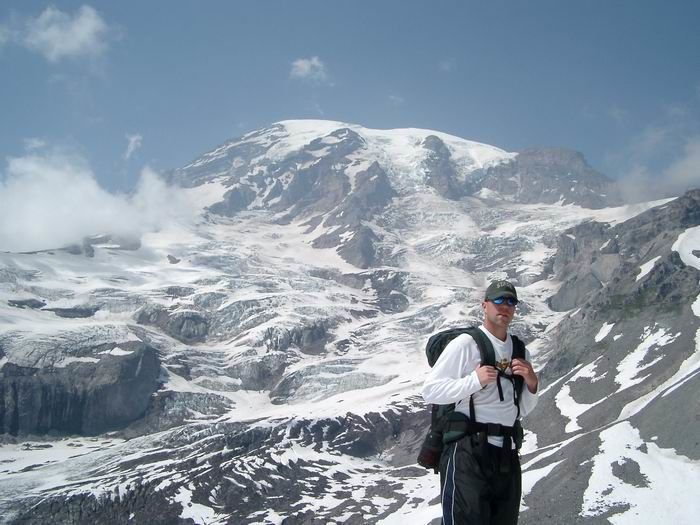 Mount Rainier and Brandon
Mount Rainier and Brandon
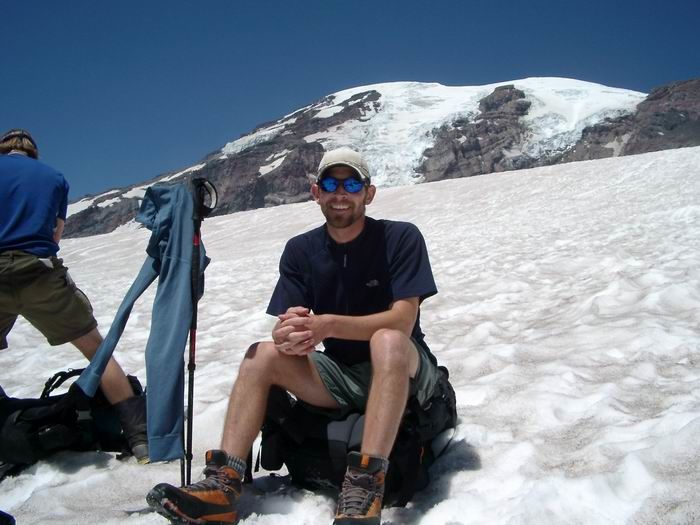 James on the approach.
James on the approach.
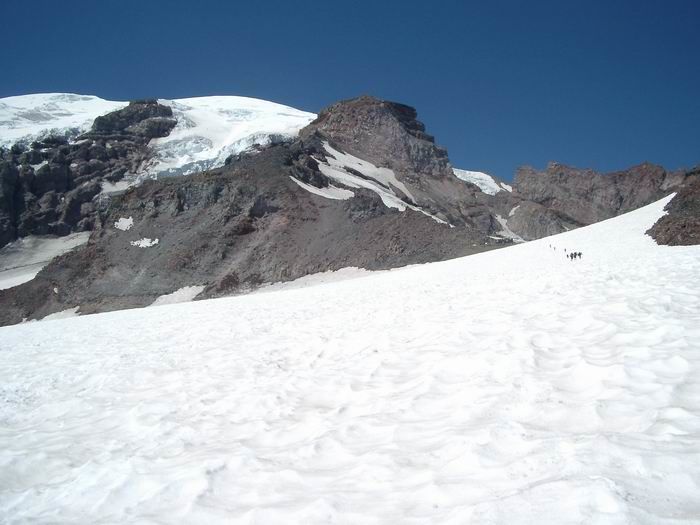 Cathedral Rock
Cathedral Rock
 Camp Muir
Camp Muir
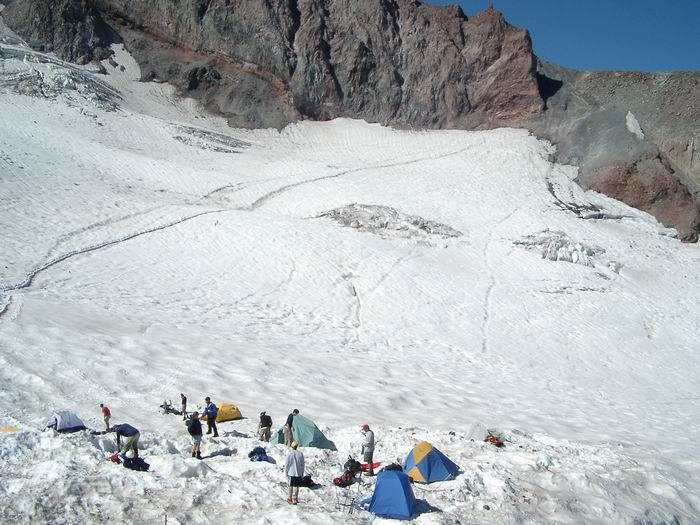 Start of the climb.
Start of the climb.
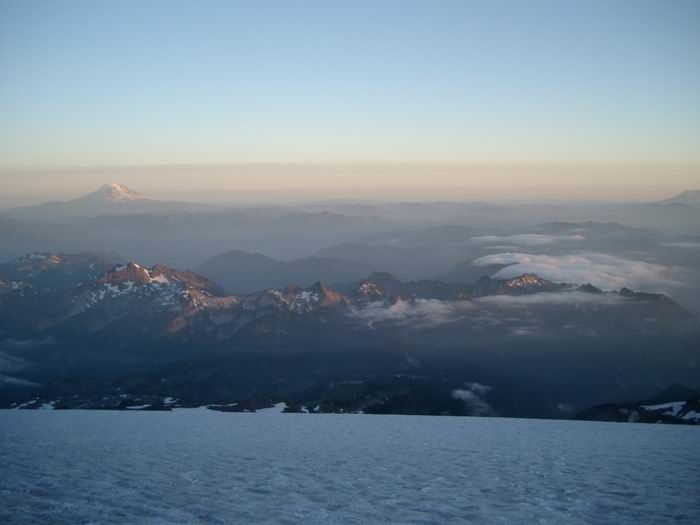 Sunset
Sunset
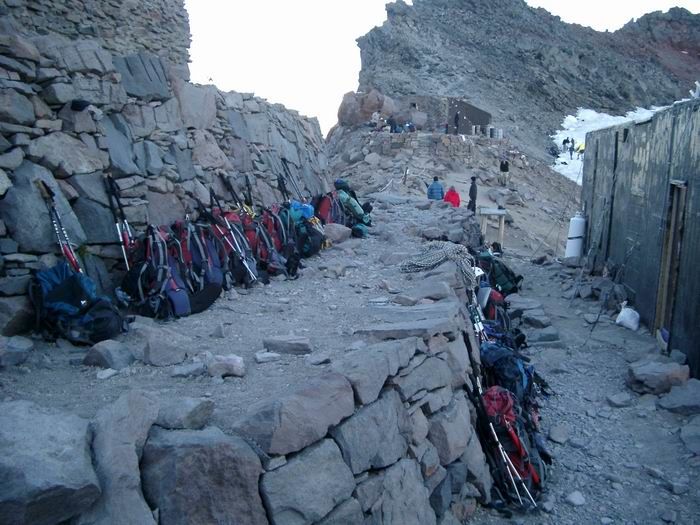 Camp Muir
Camp Muir
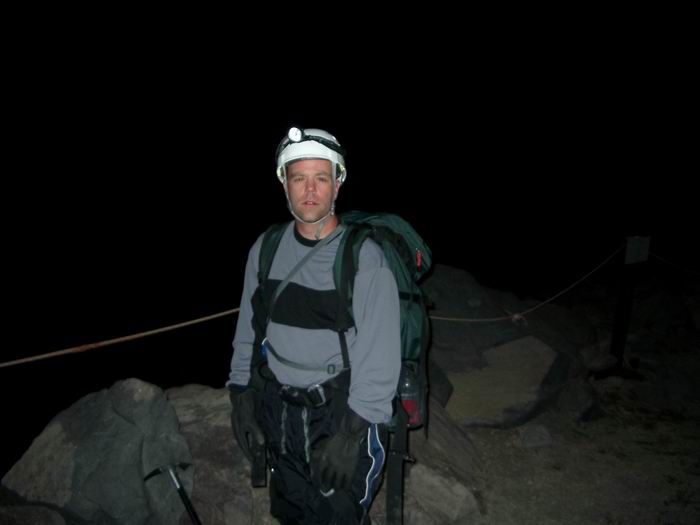 Brandon
Brandon
 Rope Teams
Rope Teams
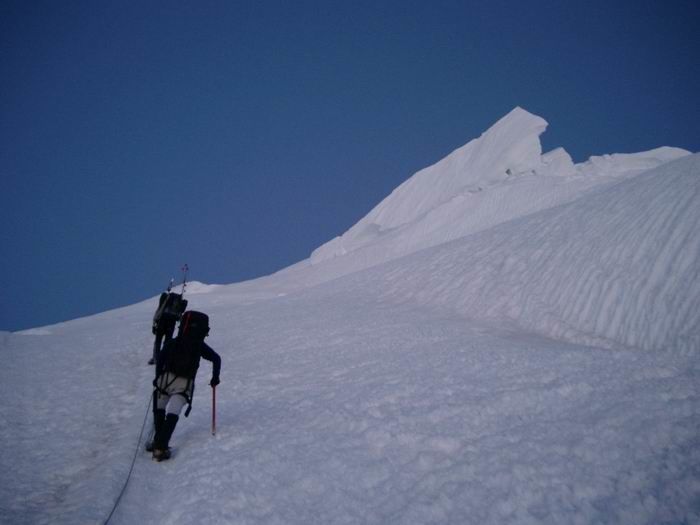 High Break
High Break
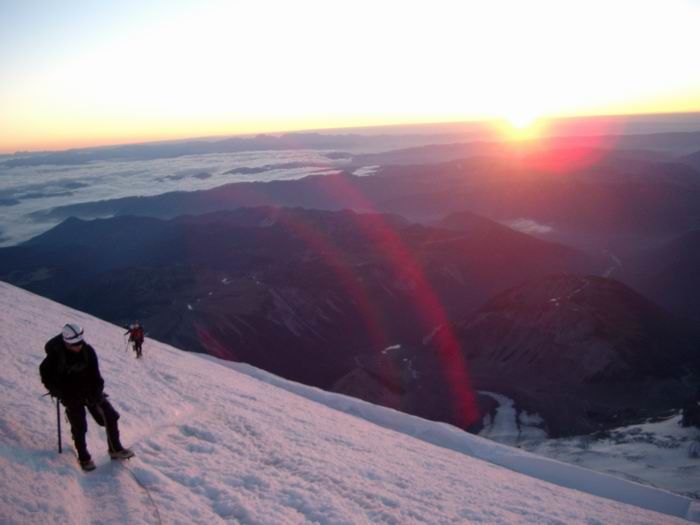 Sunrise
Sunrise
 Crater Rim Rocks
Crater Rim Rocks
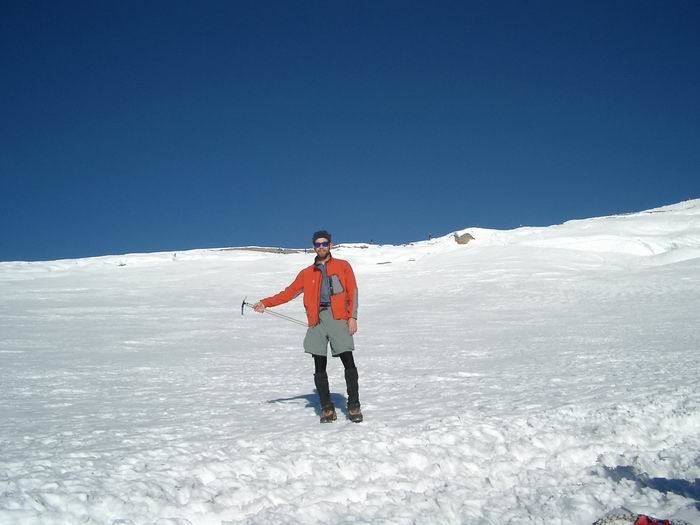 Base of the Crater
Base of the Crater
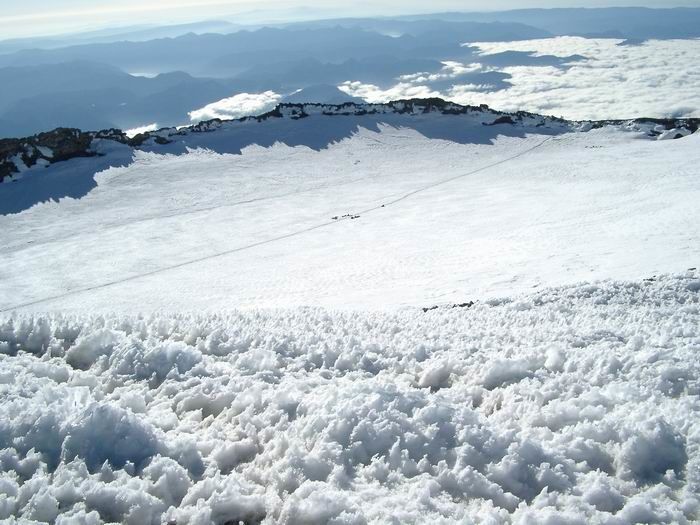 Crater from Columbia Crest
Crater from Columbia Crest
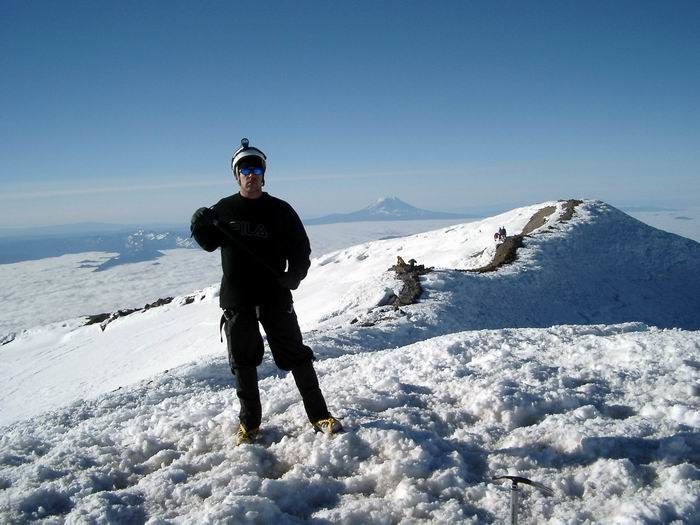 Brandon
Brandon
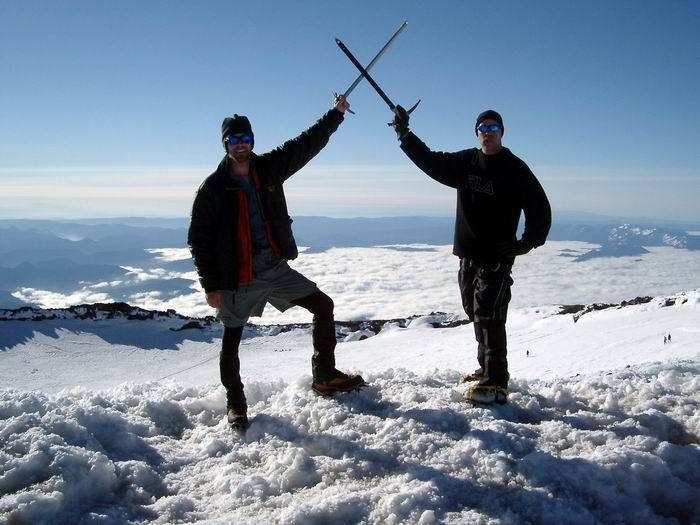 Mount Rainier Summit
Mount Rainier Summit
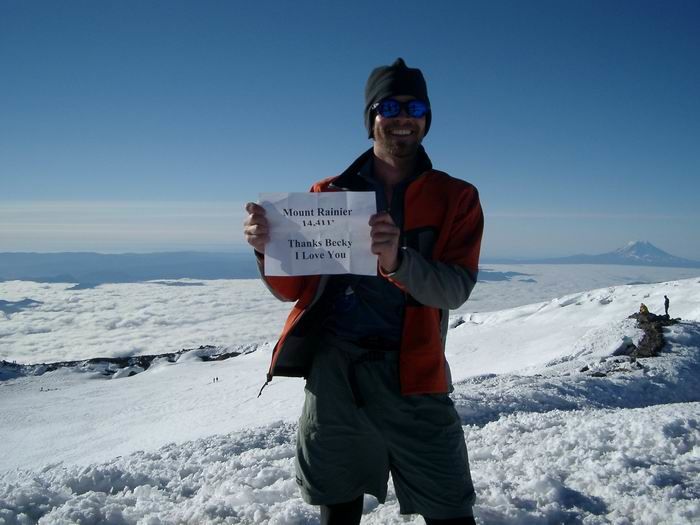 Summit Photo
Summit Photo
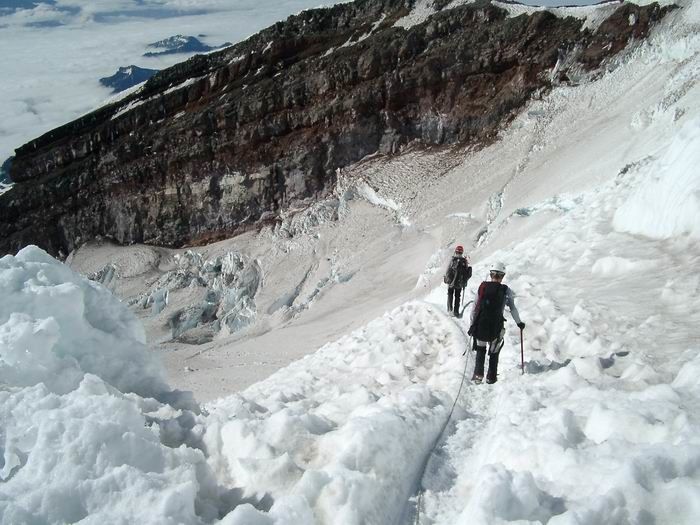 Descent
Descent
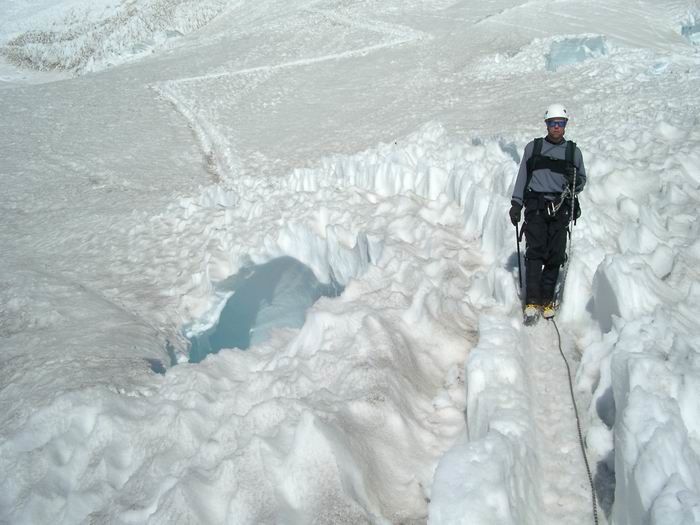 Crevasse
Crevasse
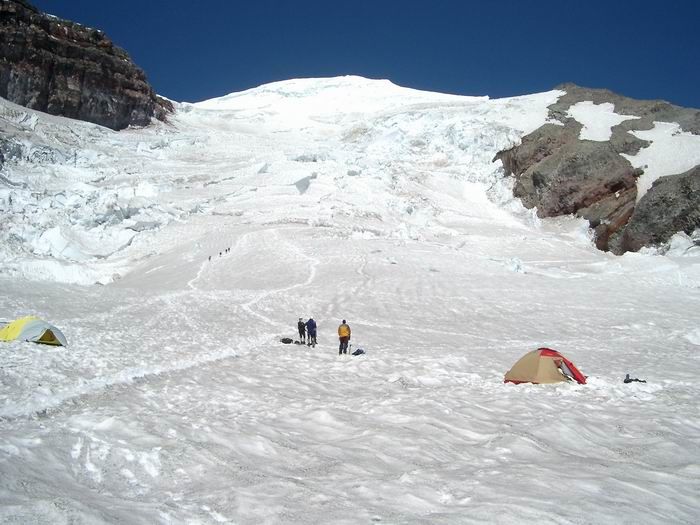 Ingraham Glacier from Ingraham Flats
Ingraham Glacier from Ingraham Flats
 Disappointment Cleaver
Disappointment Cleaver
 Looking down the Muir Snowfield.
Looking down the Muir Snowfield.
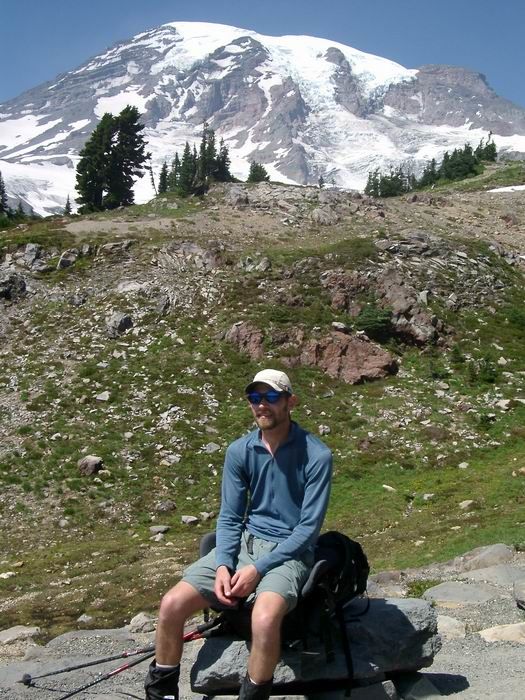 Mount Rainier
Mount Rainier
 Mount Rainier
Mount Rainier
 Mount Rainier
Mount Rainier
